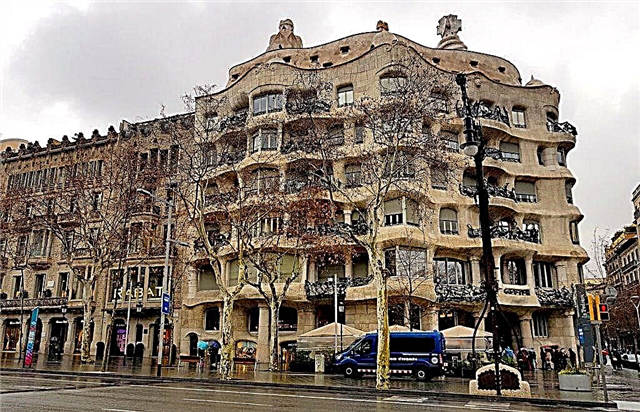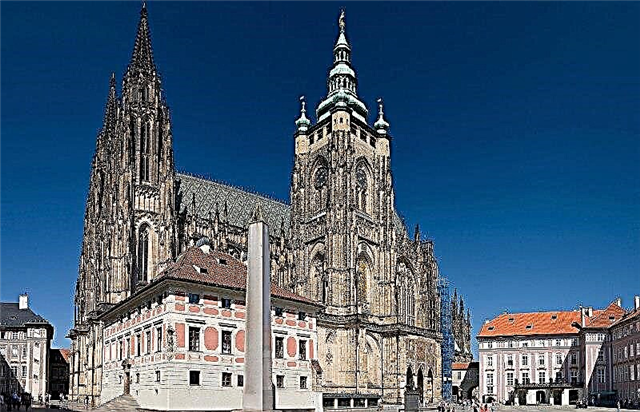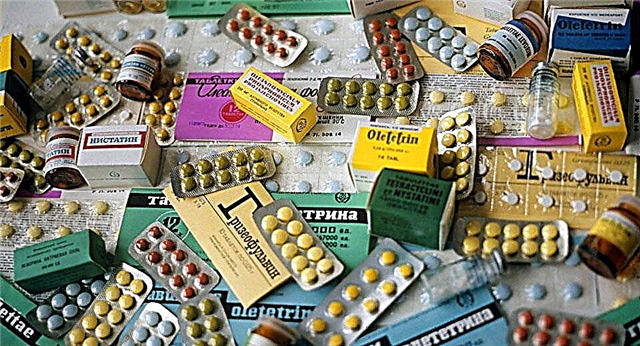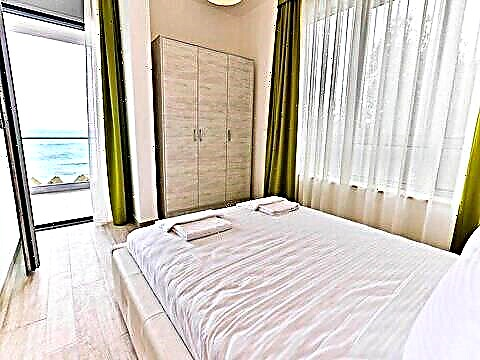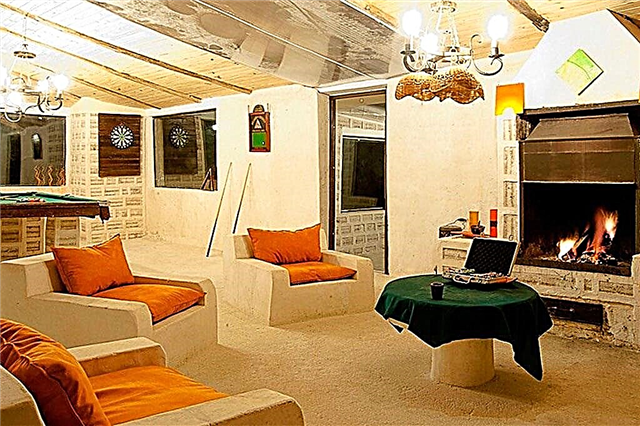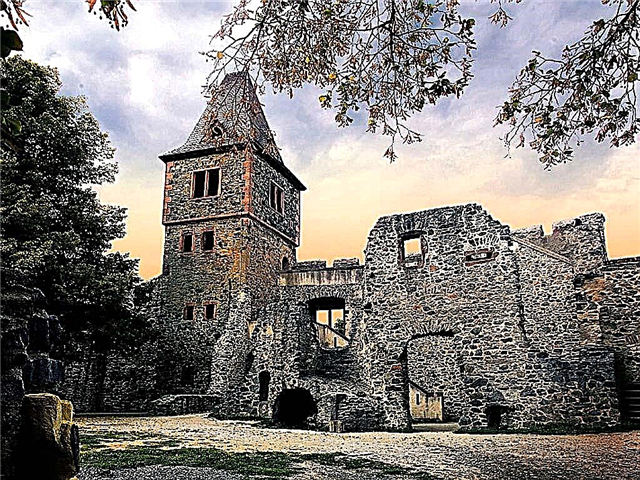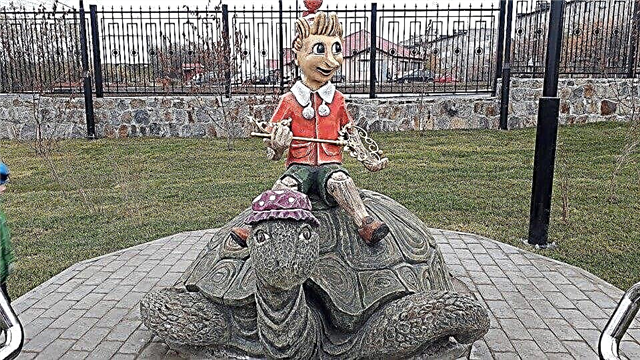The city of Murmansk, located beyond the Arctic Circle, is called the "northern sea gate of Russia." Founded in 1916 near the Northern Sea Port, it stretches along the rocky coast of the Kola Bay of the harsh Barents Sea for almost 20 kilometers. The uniqueness of the polar city lies in its unusually beautiful northern nature, polar days lasting 50 days and polar nights, covering it for 42 nights.
The austere northern beauty and sights of Murmansk, both left over from the tsarist government and modern ones, create a special atmosphere of the city. In the period from September 1 to April 15, tourists have a chance to see the main natural attraction of the Arctic Circle - the Northern Lights.
Nuclear icebreaker "Lenin"

The silhouette of the legendary first-ever atomic icebreaker "Lenin", built in the USSR in 1957, is impressive already when approaching the Murmansk seaport. Here in 1989, after serving its working term, the icebreaker was put up at the sea station, becoming a museum complex.
The enormity of the ship is evidenced by its impressive dimensions. In length, it stretched for 134 meters, and its displacement was 16 thousand tons. Taking an excursion around the firstborn of nuclear icebreaking, tourists will see the working rooms of the ship and the cabins for the rest of the crew members, who numbered 243 people.
They will tell you how an icebreaker could continuously sail autonomously for a year, opening the way for caravans of ships in the Arctic ice. Tours on the nuclear-powered icebreaker "Lenin" last one hour, starting at 12:00 on weekdays, and from 11:00 to 15:00 on weekends.
Memorial "Defenders of the Soviet Arctic during the Second World War"

The memorial to the defenders of the Soviet Arctic during the Great Patriotic War, erected in 1967, has become the hallmark of Murmansk. The monument was erected on a hill where an anti-aircraft battery stood in 1941, which defended the city from bombing. On a seven-meter pedestal, the majestic figure of a Soviet soldier in a raincoat and a submachine gun over his shoulder rises to 31.5 meters. The townspeople affectionately call him Alyosha.
Near the monument on a podium made of black stone, the Eternal Flame does not go out. The stern gaze of the warrior is turned to the west, from where the invaders came in 1941. The memorial complex ends with a sloping three-sided pyramid, installed at a distance behind the monument. It symbolizes the battle banner, which was lowered as a sign of mourning for the dead soldiers.
The ensemble is complemented by a granite stele with the name of military units, border and partisan detachments that fought for the city and anti-aircraft guns that served as the protection of the port city. The Alley of the Hero Cities of the Soviet Union leads to the memorial.
Monument "Waiting"

In the city, recognized as the cradle of the northern navy, sailors and fishermen who have gone to sea are waiting for the fate of their mothers, wives and girlfriends. To relatives and friends anxiously awaiting loved ones from the voyage in 2012, a monument "Waiting" was erected.
The idea of creating such a monument was the poem "Sentimental Watch", written by a former navigator of one of the fishing boats. A quatrain from the poem about a waiting woman as the image of the whole earth is engraved on the slab near the sculpture.
A three-meter bronze sculpture of a girl with a scarf in her hands rises on a massive three-meter granite pedestal weighing 18 tons. She looks at the Kola Bay, seeing off her loved ones to the sea and meeting them from the voyage.
The total height of the "Waiting" monument of 6 meters impresses with its monumentality. In the center of the granite pedestal are engraved the words "Those who know how to wait ...", and at its foot, a sea wave is depicted in a bas-relief. The monument "Waiting" has become a symbol of love and fidelity for the residents of the city.
Five Corners Square

The outlines of the main city square, laid out at the intersection of five roads, amaze with the non-standard pentagonal rhombus shape.
From here the "Five Corners" square got its unusual name in the 90s of the last century. It is called the heart and birthplace of the polar city, because it was at this place in 1916 that the first stone of the Church of St. Nicholas of Mirliki was laid. Today, 4 streets start from Five Corners Square, which has become the business and cultural center of Murmansk.
The buildings of the regional and city government, the Regional Duma, the Drama Theater, the Palace of Culture, the Main Post Office and two large hotels: "Arctic" and "Meridian" are interwoven into its architectural appearance, which took shape in Soviet times.
The squares behind the Palace of Culture serve as green oases: a park with a children's town, a fountain and a monument to cod fish and a park behind the Arktika hotel, notable for the first city monument to the victims of the 1915 intervention and a weeping fountain.
Oceanarium

The official opening date of the aquarium is December 1991. It was created in the village of Dalnie Zelentsy on the basis of the former laboratory of marine mammals of the Academy of Sciences, which trained dolphins and seals to help people in war and peacetime.
Now this experience is used in circus training of marine animals. The Murmansk Aquarium is the only aquarium complex in Europe where harp and gray seals, Dick the sea hare playing musical instruments and ringed seals not only live, but also train and perform.
In addition, the oceanarium serves as a scientific center that studies the physiological characteristics of these animals: their sound perception, visual acuity, and ability to distinguish colors. Visitors to the aquarium admire the talent of the gray seal Fili, who is invited to perform in various circuses around the world. Other pinnipeds and mustachioed inhabitants of the aquarium are no less famous on the world circus arena.
Museum of local lore

The four-storey building of the regional museum of local lore stands out brightly on the central Lenin Avenue with its light green facade, white square columns and decor of the entrance. It first opened its doors to visitors on October 17, 1926.
Over the years, the museum has collected a large collection, of which 15 thousand exhibits are exhibited for the public to see. The regional museum has 2 unique branches.
One of them in the village of Lovozero is dedicated to the history and life of the Sami who lived on the Kola Peninsula, another branch in the village of Umba introduces the culture and life of the Pomors. The museum's expositions are of interest to thematic collections about the history of the region, about the seas and marine life of the Kola Peninsula, about birds living in the region, about tundra landscapes, minerals and others.
In connection with the reconstruction of the main building, planned by the end of 2020, these exhibitions can be seen in the hangar on Pavlova Street.
Monument to the border guards of the Arctic

In the park next to the regional drama theater there is a monument to the border guards of the Arctic, erected in 2013 in honor of the 95th anniversary of the border guard.
A representative monument to the defenders of the northern borders of the country harmoniously blended into the alley of the park and is visible from afar. Three bronze figures of a pilot, a sailor and a soldier of the ground forces in full growth are courageously standing at the A-35 border post of the Soviet-Finnish border, which the advancing Nazi troops could not cross in this place.
A dog sits near the soldiers, which has long been helping to faithfully keep watch at the border. On the pedestal, there is a piece of rock on which the border guards fearlessly stand, symbolizing the inaccessibility of the northern border. On the pedestal of the monument there is a plaque with the inscription "Arctic Frontier Guards" in large golden letters.
Naval Museum of the Northern Fleet

The opening date of the Northern Fleet Naval Museum was October 1946. It began to be created immediately after the Great Patriotic War on the basis of the city House of Officers. Today the funds of the museum have more than 65,000 exhibits, placed according to historical periods in 8 halls.
Visitors will learn in museum expositions about the history of the creation and development of the Northern Fleet through the example of documents and models of submarines, surface ships and naval aviation. All museum exhibits cover the period from 1693 to the present day.
A large exposition is dedicated to the contribution made by the Northern Fleet to the victory over Nazi Germany, its commander admirals - Heroes of the Soviet Union. The exposition highlighting the achievements of the modern ocean-going fleet is of great interest.
Of great interest are exhibitions of weapons, flags and battle banners, personal belongings, awards, documents and photographs of sailors, wartime maps and works of fine art dedicated to the Russian Northern Fleet.
Art Museum

The opening of the art museum took place in 1990 in a historic building of 1927 by local standards, located on the central street of the Comintern near the Five Corners Square. Over the years of the museum's work, an art collection has been collected in it, numbering more than 10 thousand exhibits of fine art.
Most of the collection is represented by paintings by masters of painting of the 18th-21st centuries. Among them are works by Mikhail Klodt, Boris Ioganson, Yevsey Moiseenko, Mikhail Konchalovsky, as well as paintings by Murmansk artists depicting sea and northern landscapes.
An impressive collection of graphic works by famous Leningrad painters and original tapestries is impressive. Sculpture lovers will be interested to see the works of the famous Soviet sculpture Sergei Konenkov. The section of decorative and applied arts presents original samples of art crafts in Russia.
Bridge over the Kola Bay

The automobile bridge, built in 2005 across the Kola Bay, is the main object of pride of the residents. It stretches in four lanes of 2.5 km, connecting the two shores of the bay and providing automobile communication with the regions of the Murmansk region located in the west, with Finland and Norway. All technical characteristics of the bridge meet modern requirements. From it, at any time of the year, beautiful views of the hills open, and at night the bridge looks magical in a fairy-tale illumination.
The bridge crossing in the summer became the venue for the annual Murmansk Mile sports and entertainment festival.
Its exciting program consists of a sailing regatta and a swim across the Kola Bay; beach volleyball and mini-football on the sand; cycling and skateboarding. However, the main sporting event of the festival is the massive athletics race at a distance of 1611 meters.
Park "Northern Lights"

"Northern Lights" is an active recreation park with a wide range of services according to the interests and age of visitors. One of the types of outdoor recreation offered by the park are one-day tours to nearby lakes for fishing and distant reservoirs with an overnight stay, from where fishermen return with a catch of fish and shrimp. In summer, banana rides from 1 km to 3 km are organized here, and in winter, husky and reindeer sledding. Vacationers can rent a grill house, eat in a cafe.
The highlight of the park is the Northern Lights gallery. It is known that many tourists go to the Arctic to see this mysterious and stunning natural phenomenon with their own eyes. The Northern Lights Gallery has created an atmosphere of the Far North with interactive screens showing unique video footage of the northern lights, installations and music. An approach to the real situation of the North was the finding in the gallery of a real plague made of reindeer skins.
Husky kennel "Smile of Alaska"

A visit to the “Smile of Alaska” sled dog kennel brings a huge range of positive emotions from communicating with dogs surrounded by the nature of the Kola Peninsula. A 15-minute drive from the city, you find yourself in another world, where 70 charming husky dogs are greeting you, happily wagging their tails.
Visitors see the equipment of sled dogs as they are prepared for dog sledding competitions and expedition trips. Wet-nosed huskies let them touch themselves, feed them, play with them and take memorable photos. In addition to dogs, the nursery is also home to two reindeer and a fox couple.
It was a great pleasure for the kids to get acquainted with the real home of the Indians - teepees and the opportunity to fry the nipples at the stake. In "Smile of Alaska" the visitor will be offered to make an exciting five-kilometer dog sledding trip in winter. Summer tours of the kennel include a trip with mushers who tell interesting stories about the life of a husky.
Musical alley

There is an alley in the city called the Musical Alley of Love by the Murmansk people. This place received such a romantic name for the sound of classical music, to which couples in love like to stroll.
The alley leads to the city college of arts, from where the sounds of music fly, and musicians like to sit on benches that imitate piano keys, playing melodies. The decoration of the Musical Alley is a cobblestone path with trees, shrubs, lawns and flower beds on both sides.
An arcade of neon hearts, magically glowing in the evenings, runs along the pedestrian path, for which this place is also called the Heart Alley. The unique magical aura created by the music and light emanating from the heart-shaped arches made the Musical Alley recognized by the National Geographic Traveler Russia magazine as the most romantic place in Russia. Today, the Musical Love Alley has become a favorite place for wedding photo shoots.
Church of the Savior on the Waters

The Church of the Savior on the Waters (Savior of the Image Not Made by Hands) is an Orthodox church, named after the icon of Christ walking on water. It was built in 2002 as part of a memorial complex dedicated to the memory of sailors who died in peacetime.
The architecture of the church is a one-apse quadruple, completed with one golden onion with a cross. The snow-white temple stands out for its traditional Old Russian style. The temple is adjoined by a three-tiered hipped-roof bell tower topped with a golden onion and a cross.
Inside the church are collected icons revered by Christians: Christ walking on the waters, the Primordial Apostle, the Mother of God, the Holy Matrona of Moscow, the Monk Seraphim of Sarov. These and other icons have taken their place in the church iconostasis, carved from linden in the northern style. Also, an honorable place in the church is occupied by the icons of the northern saints, miracle workers helping sailors - the Monks Tryphon of Pechenga and Barlaam of Kerets.
Monument "Broken Heart"

The Torn Heart monument, unveiled in August 2001 on the anniversary of the sinking of the Kursk submarine, honored the memory of Murmansk residents who gave their lives fulfilling their military duty during local military conflicts.
The symbolic heart of red granite, torn from the inside by a cast-iron tree, depicts life and death in an inseparable unity. The personification of life was half a tree with leaves on branches and death - the other half with dead branches.
The tree rises 2.4 meters high inside the heart of the entire three-meter composition. The lower part of the monument is surrounded by a black granite ribbon with an inscription in gold letters "To Murmansk citizens who died in the line of military duty and defending the interests of the Fatherland." There are always fresh flowers at the monument, and on the day of the Airborne Forces, commemorative events are held here.
Monument to A.F. Bredov

A monumental monument to the Hero of the Soviet Union, Murmansk resident Anatoly Fedorovich Bredov, erected at the expense of the townspeople, was paid tribute to the memory of his immortal feat in defending the city from the Nazi invaders.
Bredov, fighting in the battles of the Great Patriotic War, was the commander of the machine-gun section of the rifle regiment, which together with the gunner destroyed 80 Germans from his machine gun. When there was no longer a chance to fight further, he, together with a friend, blew himself up and the machine gun with the last grenade.
The monument with the figure of the hero was unveiled on May 9, 1958. A three-meter-high sculpture of a soldier shows him at a moment of extreme physical and mental stress.
A grenade is squeezed in his right hand raised high, and the hero's face reflects the willingness to stand to the end. The resolute figure of a fighter with a fluttering cape-tent emphasizes the aspiration for the last throw from a monolithic granite block.
St. Nicholas Cathedral

In the architectural complex of St. Nicholas Cathedral there is an ensemble of temples built from 1986 to 1989. The cathedral, named after St. Nicholas - the defender of sailors and travelers, and the nearby church of Tryphon of Pechenga, the founder of Orthodoxy on the Kola Peninsula, the chapel of the Mother of God icon "The Conqueror of Breads" and the bell tower are in harmony with the surrounding harsh polar nature.
The cathedral, built of white sand-lime bricks, has a strict external appearance. It is crowned with blue onion-domes with crosses: four small ones on the sides, and a large main golden dome on the central drum. The interior of the cathedral is much richer than its appearance. It delights with its beautiful iconostasis and elaborate wall paintings.
The main relic of the cathedral is myrrh, brought from the icon of St. Nicholas the Wonderworker from the church in the Italian city of Bari, where St. Nicholas served. Among the sacred relics kept in the cathedral, you can touch the particles of the holy relics of Matrona of Moscow, Seraphim of Sarov, Saint Innocent.
Waterfall on the Lavna River

This natural landmark is located 20 kilometers from Murmansk behind the Abram-Cape. The waterfall owes its birth to the turbulent Lavna River, rushing 21 kilometers from the lake of the same name to the Kola Bay.
A stormy stream of water along cascades and rapids falls from a height of 4 meters, delighting with the abundance and surroundings of picturesque nature: endless forests and flowering fields in summer. The coast of the slope on the way to the bay is littered with stones, overgrown with lichen and moss from moisture. Near the cascade, tourists like to take pictures, and the townspeople like to have picnics with barbecue.
The waterfall also gives pleasure to fishermen, who often return with a catch of perch, pike, burbot and other local fish. Only brave daredevils will be able to swim in Lavna - the water here remains cold even on hot days, and the current is too strong.
The waterfall is especially full-flowing and powerful in spring, but even in winter in frost, most of it does not freeze, which makes an indelible impression.
Raven stone

In the Pervomaisky district, the rocky summit of the Goreloi hill attracts attention with a fantastic view of a stone structure called the Voroniy Kamen megalith. There are many scientific hypotheses and fantastic legends around this stone miracle of nature.
There are claims that this mysterious structure remained from Hyperborea - the place of residence of the ancestors of mankind, who flew from space to Earth. Close to this theory is the hypothesis of the existence of an ancient civilization of the Land of the Light, the Solar Country or the White Earth.
Some scientists claim that the Raven Stone appeared under the influence of a glacier. There are also such amateur scientists, who call this natural miracle an ancient observatory, where the gap visible between its side plates is compared to the female womb, “where the moon ray penetrates as a male sexual organ in the full moon and“ fertilizes ”it." However, the question of how this structure appeared at the top is still open.
Ostrich farm

It is surprising that in the Arctic, on the permafrost, you can see African ostriches. They feel great at the Northern Lights ostrich farm, opened in 2007 in the village of Molochny, one of the Murmansk families. The southern birds, which survived the formidable dinosaurs in ancient times, moved here from Vilnius and quickly got used to it. In addition to ostriches, the farm is inhabited by families of birds: quails, geese, ducks and Indo-ducks, peacocks and a formidable eagle.
Meet representatives of the larger fauna: deer, sheep, goats and rabbits. In a word, the Northern Lights farm can be called a contact zoo, because here you can stroke, feed and take pictures with animals and ostriches, see nests and chicks hatched from eggs, ride horses and ATVs.
The farm will offer to buy organic products: ostrich and quail meat, eggs, rabbit meat and goat milk products. A local guide will tell you a lot about the habits of the inhabitants of the farm.
All Saints Church

The Orthodox Church of All Saints rises on a hill in the Eastern microdistrict of Murmansk. There are many interesting events in the history of the construction of the temple.
After the Divine Liturgy, held in 2000 on the hill where the construction of the temple was supposed to be, a procession was made to a nearby source, which was consecrated in honor of the Murmansk saints, the wonderworkers Peter and Fevronia. Earlier, near the source, a miraculous image of a cross was found on a stone.
By the end of 2003, a small wooden chapel was built here at the expense of the townspeople. After some time, the building of the chapel was expanded with a full-fledged altarpiece and turned into a real church where divine services are held.
And for several years, a new red-brick church rises next to the old chapel. A large dome glittering with gold flaunts on it, small golden domes sparkle on the apse of the temple and the bell tower. Now the church has a Sunday school and a library.
Raccoon

On Oktyabrskaya Street there is an interesting establishment called Enotopolis. It cannot be called a petting zoo or a circus. Officially "Enotopolis", where raccoons live as a friendly family, is called the Zootherapy Center.
Visitors to the center can see how these fluffy thieves live and what they do, tidying up everything in their paws. There are no cells in the center, so contact with funny animals takes place close. You can feed them, drink them, pet them, wear them in your arms, but be careful at this time, because cute raccoons love to fumble in their pockets.
Visitors will be warned that if an animal is pissed off, it may bite. From the all-knowing raccoon instructor, you will learn a lot about the habits of these animals. Throughout the territory of "Enotopolis" you can take pictures and shoot on video. When planning to visit this amazing institution, keep in mind that raccoons sleep and weekends are strictly according to the schedule, so you need to sign up for a visit in advance.
Children's town "Fairy Tale"

The children's town "Skazka" has become an adornment of the central Leninsky district. It was built on the site of an old town with red brick towers, dilapidated over the years. Today "Fairy Tale" is called the youngest landmark of the city. A fabulous town has grown up near the monument to "Alyosha".
Immediately upon entering its gate, guests are greeted by a huge figure of the Serpent Gorynych with a cheerful and kind expression of all three heads. Next to him are three heroes, in relation to the size of the three-headed monster, they look like gnomes.
To the right of the Serpent Gorynych stands the funny Baba Yaga, and throughout the town you will meet her two girlfriends - in a hut on chicken legs, with an accordion in her hands and a cat on her shoulder.Also in the town, meet other heroes of popular cartoons and fairy tales. In the "Fairy Tale" there are many towers, houses where fairy-tale heroes live. Children play with great pleasure on the playground, decorated under the "Flying Ship".
Museum of Entertaining Sciences "Focus"

In the museum of entertaining sciences "Focus", located within the walls of the regional scientific library on Sofia Perovskaya street, you are immersed in the entertaining world of science, full of secrets and mysteries, interesting for visitors of different ages. In its halls, each person will make amazing discoveries for himself and acquire new knowledge. In "Focus" most of the presented museum exhibits are interactive. It is allowed to experiment with them, conduct experiments, play.
On weekends in the museum, you can take part in exciting master classes, watch a scientific show program using water, magnets, air, vacuum and electricity. It is also curious to carry out all sorts of experiments and experiments myself. In the Focus Museum, everyone can become the creator of a unique product: an author's mug, a woven bracelet, a volumetric plastic figure drawn with a 3D pen and take part in an exciting quest.
Museum of the History of the Murmansk Commercial Port

Next to the pontoon pier of the seaport is the building of the Museum of the History of the Murmansk Commercial Seaport, opened in 2015.
A reference point for the tourist is the atomic icebreaker-museum "Lenin", which is standing near the museum, which has served its time. For a short time of its work, the museum has become a popular place for residents and guests of the Arctic. It provides a meaningful presentation of more than a century of history of the port, from its inception to the present day.
Thanks to all residents of the city, unique documents, photographs and objects have been collected that tell about the stages of the formation of a commercial port. The museum has many interesting models of merchant and other ships and 37 illuminated photo panels. In six main museum sections, arranged in a sequence of historical milestones - from exploration work to modern achievements, moving from one exhibition to another, as if moving in time.


